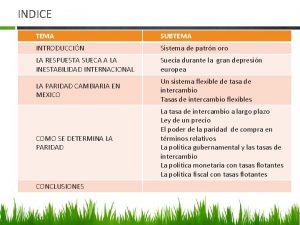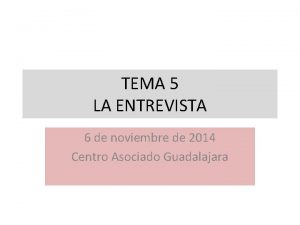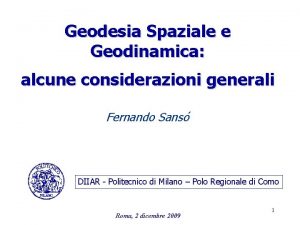ALCUNE CONSIDERAZIONI MEDICAL KEY SCIENTIFIC IN TEMA DI















- Slides: 15

ALCUNE CONSIDERAZIONI MEDICAL KEY SCIENTIFIC IN TEMA DI EQUIVALENZA DEPARTMENT E SOVRAPPONIBILITÀ 2016 -2017 RESULTS AND PLANNING Mario Mangrella Medical & Scientific Affairs Director Mario Mangrella Italfarmaco Sp. A

THE THERAPEUTIC CONUNDRUM Adherence, Pharmacokinetics, Medical history, Co-morbidity, Co-treatments, Special populations, Drug resistance/tolerance, Epidemiology & Genetics, Safety/Tolerability, Patient preference, information, expectations, trust, satisfaction, a. o. PATIENT MEDICINE Pharmacodynamics (Mo. A, a. o. ) DISEASE Medical Scientific. Department Affairs Department Medical&Scientific

THE ATC CLASSIFICATION • First level Anatomical main group • Second level Therapeutic subgroup WHERE DOES PATIENT END UP? • Third level Therapeutic/pharmacological subgroup • Fourth level Chemical/therapeutic/pharmacological subgroup • Fifth level Chemical substance Medical Scientific. Department Affairs Department Medical&Scientific

EQUIVALENZA TERAPEUTICA Determina 818/2018 Possono essere ammessi alla valutazione di equivalenza terapeutica farmaci in possesso dei seguenti requisiti: 1. essere dei principi attivi per i quali vi sia esperienza d'uso, intesa come periodo di rimborsabilità a carico del Servizio sanitario nazionale di almeno 12 mesi; 2. presentare prove di efficacia che derivano: – da studi che non consentono la dimostrazione di superiorità di un farmaco rispetto all'altro (ad es. studi vs placebo), oppure – da studi testa a testa che non prevedono un'ipotesi di superiorità (ad es. confronti attraverso studi di equivalenza o non inferiorità) 3. appartenere alla stessa classificazione ATC di IV livello 4. possedere indicazioni terapeutiche principali sovrapponibili (anche per quanto riguarda le sottopopolazioni target), come da sezione 4. 1 dell'RCP There is a risk of a false dichotomy, i. e. a fallacy in informal logic. The conclusion is based on lack of knowledge or evidence without accounting for all possibilities. It is excluded the possibility that there may be an insufficient investigation to prove that the proposition is either true or false. The appeal to a lack of contrary evidence is used in an attempt to shift the burden of proof. 5. utilizzare la medesima via di somministrazione 6. prevedere uno schema posologico che consenta di effettuare un intervento terapeutico di intensità e durata sostanzialmente sovrapponibili Medical Scientific. Department Affairs Department Medical&Scientific «Agenti probatio semper incumbit»

THE THERAPEUTIC CONUNDRUM AND THE CLINICAL ENCOUNTER CLINICIAN Adherence, Pharmacokinetics, Medical history, Co-morbidity, Co-treatments, Special populations, Drug resistance/tolerance, Epidemiology & Genetics, Safety/Tolerability, Patient preference, information, expectations, trust, satisfaction, a. o. THE CLINICAL ENCOUNTER PATIENT MEDICINE Time Constraints, Technology, Administrative Demands Pharmacodynamics (Mo. A, a. o. ) DISEASE Medical Scientific. Department Affairs Department Medical&Scientific

THE CLINICIAN DOES EXIST AND SHOULD BE PUT IN A POSITION TO DO THIS TOO JAMA. 2020; 323(1): 70 -81. doi: 10. 1001/jama. 2019. 19003 Medical Scientific. Department Affairs Department Medical&Scientific

Binding Profiles of Various TCAs in Terms of Their Affinities (Ki, n. M) for Various Receptors and Transporters 1 -5 Amitriptyline Clomipramine m. Ach NET H 2 SERT vs NET Selectivity SERT m. Ach Dosulepin H 2 DAT 140 NET 120 DAT 100 H 1 5 -HT 1 A D 2 5 -HT 2 A 80 60 α 2 5 -HT 2 C α 1 20 5 -HT 2 C α 1 5 -HT 6 0 5 -HT 6 5 -HT 7 Norclomipramine Nortriptyline Trimipramine SERT m. Ach NET H 2 Am i C tript lo m ylin ip ra e m i D N os ne or cl u om le ip pin r N am or i tr ne Tr ipty im l ip ine ra m in e α 2 40 NET H 2 DAT H 1 5 -HT 1 A D 2 5 -HT 2 A 1. Brunton L et al. Goodman and Gilman's The Pharmacological Basis of Therapeutics, Twelfth Edition. 2011. Mc. Graw Hill Professional. 2. Christopher MD. Prescribing Mental Health Medication: The Practitioner's Guide. 2013. Routledge. 3. Richard CD. Medical Toxicology. 2004. Lippincott Williams & Wilkins. 4. Tatsumi M et al. Eur J Pharmacol 1997; 340: 249. α 2 5 -HT 2 C α 1 5 -HT 6 5 -HT 7 TCA, Tricyclic antidepressant; SERT, Serotonin transporter; NET, Norepinephrine transporter DAT, Dopamine transporter; 5 -HT, Serotonin receptor; α, Alpha-adrenergic receptor D, Dopamine receptor; m. Ach, Muscarinic acetylcholine receptor. α 2 5 -HT 2 C α 1 5 -HT 6 5 -HT 7 Medical Scientific. Department Affairs Department Medical&Scientific 5. Roth BL, Driscol J. PDSP Ki Database. Psychoactive Drug Screening Program (PDSP). University of North Carolina at Chapel Hill and the United States National Institute of Mental Health. N 06 AA

Affinity (Ki; nmol/L) of SSRIs for Binding or Inhibiting Monoamine Transporters and Receptors 1, 2 SERT vs NET Selectivity 8000 7000 6000 5000 4000 3000 Scatter plots, Pearson correlations, linear regression, and 95% CI comparing radioligand binding and active transport in cells expressing h. SERT, h. NET, or h. DAT. 2000 1000 Es ci ta lo C pra ita m lo pr Fl uo am x Pa etin ro e xe Se tine Fl rtra uv l ox ine am in e 0 1. Brunton L et al. Goodman and Gilman's The Pharmacological Basis of Therapeutics, Twelfth Edition. 2011. Mc. Graw Hill Professional. 2. Owens MJ et al. Biol Psychiatry 2001; 50: 345. SSRI, Selective serotonin reuptake inhibitor; SERT, Serotonin transporter NET, Norepinephrine transporter; DAT, Dopamine transporter; 5 -HT, Serotonin receptor α, Alpha-adrenergic receptor; D, Dopamine receptor; m. Ach, Muscarinic acetylcholine receptor. Medical Scientific. Department Affairs Department Medical&Scientific N 06 AB

Antidepressivi Raccomandazioni Cliniche Differenziali • Nei pazienti anziani a rischio di ipotensione ortostatica, gli SSRI e gli SNRI vanno preferiti rispetto a I-MAO e triciclici; a causa del rischio di eventi avversi negli anziani, fra i triciclici andrebbero preferiti desipramina e nortriptilina rispetto ad amitriptilina, imipramina e doxepina • Negli uomini con ipertrofia prostatica andrebbero preferiti gli antidepresivi con minori effetti anticolinergici, per ridurre il rischio di effetti sfavorevoli sullo svuotamento vescicale • Nelle donne gravide o in quelle fertili che cercano una gravidanza, l’antidepressivo va scelto in base ai rischi noti dei singoli composti (teratogenicità, complicanze gravidiche, prematurità, ecc. ) • Negli ipertesi, l’antidepressivo va scelto in funzione del possibile effetto del singolo composto nell’intensificare o ridurre gli effetti del trattamento antiipertensivo • Nei soggetti con pregresse cardiopatie, SSRI, SNRI e bupropione sono da preferire rispetto ad altri antidepressivi • Nei pazienti con coronaropatia, ipertensione arteriosa o insufficienza cardiaca, vanno preferiti gli antidepressivi con minori effetti sulla frequenza cardiaca e sulla pressione arteriosa • Nei pazienti che ricevono un trattamento con un anticoagulante o un antiaggregante, va scelto l’antidepressivo che interferisce meno con il metabolismo di questi farmaci • Alcuni farmaci antiepilettici inducono un aumento dei livelli ematici di alcuni triciclici, aumentando il rischio di effetti colinergici avversi • Nei soggetti obesi, vanno preferiti quegli antidepressivi che hanno un effetto neutro sul peso corporeo (ad es. , bupropione) • Nei pazienti con AIDS, gli SSRI sono meglio tollerati dei triciclici; nella scelta del trattamento va scelto l’antidepressivo con minori interazioni farmacologiche con la terapia antiretrovirale American Psychiatric Association, Practice Guideline for the Treatment of Patients With Major Depressive Disorder, Third Edition, 2010. Medical Scientific. Department Affairs Department Medical&Scientific

Calcium-Channel Blockers - Dihydropyridines …IN THE SAME PATIENT! POOR TOLERABILITY POOR ADHERENCE ARE THESE MEDICINES EQUIVALENT? Medical Scientific. Department Affairs Department Medical&Scientific

N=131, 472 CONCLUSION Comparison of treatment discontinuation between antihypertensive drug classes masks the fact that this phenomenon is heterogeneous within any given class. This is relevant to calculations of the costbenefit of treatment, which, thus, should be drug-based rather than class-based. Journal of Hypertension 2011; 29: 1012. Medical Scientific. Department Affairs Department Medical&Scientific a, Department of Clinical Medicine and Prevention; b, Department of Statistics, Unit of Biostatistics and Epidemiology, University of Milano-Bicocca; c, Operative Unit of Territorial Health Services, Region Lombardia, Milan, Italy

La conoscenza scientifica “cerca ed esige differenziazione” Il rischio da evitare: …die Nacht worin alle Kühe schwarz sind… …la notte in cui tutte le vacche sono nere… Georg Wilhelm Friedrich Hegel (1770 -1831) “Phänomenologie des Geistes” (1807) Medical Scientific. Department Affairs Department Medical&Scientific

THE SAME PATIENT IS NOT ALWAYS THE SAME MEDICINE MAY BE NOT EQUIVALENT TO ITSELF IN THE SAME PATIENT Medical Scientific. Department Affairs Department Medical&Scientific Changes in Pharmacokinetics, Co-morbidity, Co-treatments, Special conditions, Drug resistance/tolerance, Epidemiology, Safety/Tolerability, Patient preference, information, expectations, trust, satisfaction, a. o. depending on Age, State of Health, a. o.

Medical Scientific. Department Affairs Department Medical&Scientific

ALCUNE CONSIDERAZIONI MEDICAL KEY SCIENTIFIC IN TEMA DI EQUIVALENZA DEPARTMENT E SOVRAPPONIBILITÀ 2016 -2017 RESULTS AND PLANNING Mario Mangrella Medical & Scientific Affairs Director Mario Mangrella Italfarmaco Sp. A
 Considerazioni sull'adolescenza
Considerazioni sull'adolescenza Homework countable or uncountable
Homework countable or uncountable In un certo mese dell'anno per 3 volte il martedi
In un certo mese dell'anno per 3 volte il martedi Tema-tema teologi perjanjian lama
Tema-tema teologi perjanjian lama Subtema
Subtema Entrevista estructurada caracteristicas
Entrevista estructurada caracteristicas Aliran seni patung
Aliran seni patung Ejemplos de temas delimitados
Ejemplos de temas delimitados Scientific inquiry vs scientific method
Scientific inquiry vs scientific method How is a scientific law different from a scientific theory?
How is a scientific law different from a scientific theory? Tema medical
Tema medical Which key activities do partners perform
Which key activities do partners perform Business model canvas tripadvisor
Business model canvas tripadvisor California medical license application
California medical license application Gbmc medical records
Gbmc medical records Difference between medical report and medical certificate
Difference between medical report and medical certificate





























